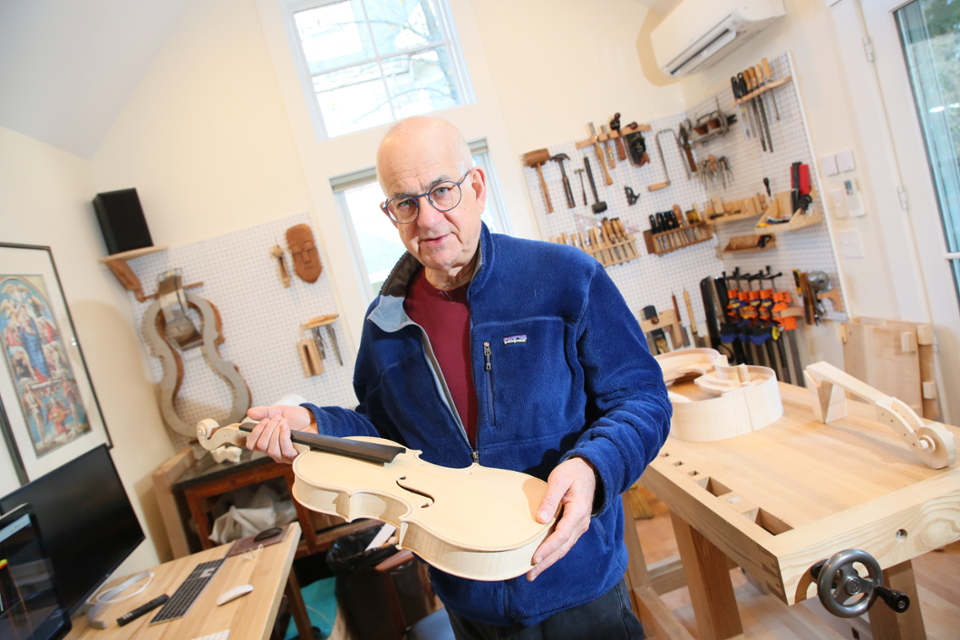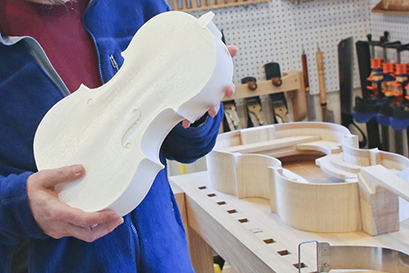Sharing the “secrets of Stradivari”
Computer Science Professor Harry Mairson’s focus outside the classroom is on building violins, violas, and violoncellos. And he’s brought his digital tools to this work.
 Photo/Mike Lovett
Photo/Mike LovettComputer Science Professor Harry Mairson holds an unfinished viola, based on the Brothers Amati “Grand Pattern” model.
Computer Science Professor Harry Mairson’s focus outside the classroom is on building violins, violas, and violoncellos. At the same time, he’s trying to understand and share the “secrets of Stradivari,” and those of other great Italian makers of renowned classical stringed instruments. And he’s brought his digital tools to this work, together with his workshop’s traditional hand tools.
In collaboration with the Museo del Violino in Cremona, Italy, in 2017, Harry organized a high-resolution CT scan of the 1700 “Stauffer-ex Cristiani” violoncello made by the incomparable Antonio Stradivari. Interpreting the scan with computer software he developed, he recreated its proportional, Renaissance geometry, a design technique used by that era’s architects, furniture makers, and musical instrument makers.
With Ian Roy, director of the Brandeis Maker Lab (“my best colleague at Brandeis,” says Mairson), they printed a 3D copy of the cello, now serving as a study object at the Museo. And he recently finished a technical folio of CT images of the instrument, exactly sized for accurate measurement, available through the Museo for study by luthiers, musicologists, and the interested public.
This project was presented last September at the Mondomusica International Exhibition and Festival in Cremona. It was supported by Brandeis, the National Endowment for the Humanities, the Gladys Krieble Delmas Foundation — and the National Science Foundation.

Mairson's Mac Pro has a colossal 768GB of RAM, enough to enable him to manipulate CT scans of instruments.
Contemporary luthiers follow their craft’s historical canon with extreme fidelity. But individual examination of such famous instruments is problematic: they are coveted by virtuosos and collectors, few in number, fragile, very costly, and thus largely inaccessible. Mairson has emphasized that with software tools, we can replace their hands-on examination with comprehensive digital access, available to everyone.
“Just getting physical access to this violoncello took three years of writing to people, and building good relationships with them,” says Harry. “And with visualization software, I now can see virtually everything about this incredible instrument as if it was in my workshop, and in even greater detail than I would have with the original.”
Mairson showed BrandeisNOW his off-campus workshop, where his hand planes, gouges, saws and calipers sit right next to his computer — a Mac Pro desktop machine with a colossal 768GB of RAM, enough to manipulate digital images easily in 3D (“a gamer would love this,” Harry says).
His dual goals are to provide greater access to these great instruments, and to make some good ones of his own at the same time. Harry is working on his second cello built on the “Cristiani” model. The first one got good reviews from Josh Gordon, the cellist in Brandeis’s Lydian String Quartet. It’s now played by Mairson’s son Simon, an accomplished musician.

Mairson holds a 3D-printed model.
BrandeisNOW: You’ve been interested in musical instruments since you were quite young. At what point did your interest in instruments and computer science begin to merge?
My beloved father was an engineer who had a workshop, so a lot of this came naturally. I started programming in sixth grade (that was something in the 1960s!), and built a harpsichord from a kit when I was 17. In college, I spent a year in England working for a harpsichord maker. In graduate school, I built a clavichord based on one in the Smithsonian Museum, a keyboard instrument that I recently restored for our older son Gabriel, who is also a French horn player.
My interests in musical instruments and computer science really converged when I learned about the Renaissance proportional geometry of classical stringed instruments—how they were traditionally designed with a straightedge and compass. I tried to do it myself on paper, and made a mess of it. Then I realized—you get a computer to do this! I designed a programming language to carry out the same geometric constructions. Instead of digging holes in paper with my compass and erasing mistakes, I debug code. It’s faster, easier, and produces a beautiful result. I’ve given courses on how to do this for violin makers all over the world.
Talk about the human networking, as opposed to computer networking, it has taken over the years to bring about the amount of cooperation it took to enable you to scan the Stauffer-ex Cristiani.
I moved to Cremona in 2016 for four months, on sabbatical, with this project in mind—I love this violoncello, and spent hours looking at it in its glass case at the Museo del Violino. I hung out with violin makers and people at the Museo, learning from them, being inspired by their utter devotion to what they do, and sharing my own expertise and enthusiasm. I carved a cello scroll and pegbox at the Istituto Stradivari—a vocational high school that trains violin makers. I learned some Italian. I made wonderful friends. They came to trust my commitment, and sense my engagement. We love the same things. You just can’t have too many friends.
How has your work with instruments informed your other research and your teaching over the years?
The domain-specific programming language I created for this musical instrument work is software that’s profoundly inspired by a course on programming language design and implementation that I have been teaching to undergraduates for years. When I realized that computer science ideas that I’ve done research on and taught about could help me climb this other learning curve, my heart kind of jumped. I’m now trying to bring undergraduates into this work.
Chris Tighe, a Brandeis senior, is working with me on using a CNC (computer numerically controlled) machine to carve the front and back of a cello. Gcode is a programming language that tells a CNC machine where to cut wood, just like PDF is a programming language for telling your printer where to put ink. We’re not using generic CAD/CAM software to generate gcode—we’re generating it directly from our own software. We think we can do a better job, because our software is designed just for this application.
How do you hope your work scanning instruments will be used in the future?
I want to build a digital library of iconic instruments from the Italian “golden age” of violin making, repeating the workflow from my project with the “Cristiani” for a dozen or more renowned instruments. It would provide an unprecedented resource for musicologists and luthiers to measure exemplars, and examine canonical construction methods.
This kind of online library could be a foundation for a digital art history. How did Stradivari cello designs evolve? What did his violin designs incorporate from those of Andrea Amati, the Cremonese luthier credited with making the first violin? How did Amati inspire other violin makers? By describing their design ideas in code, we can explain evolving changes in design by changes in the code.
The point here isn’t to be gratuitously ahistorical—it’s that the code expresses artistic and artisanal ideas that must have been on the minds of these people. Coding is a form of writing, and computer programs aren’t just to tell machines what to do. They are also a way for people to explain ideas to each other.
Categories: Arts, Research, Science and Technology





